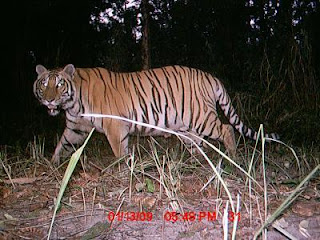Wildlife Conservation
Wildlife Conservation
Background: Conservation means protection as well as sustainable utilization of biome or other resources. They are meant for human beings and their volume should not be decreased. In conservation there should be balance between protection and utilization.In other words, it can be defined as the planned management of natural resources to prevent exploitation, destruction or neglect. If some protective measures are not taken, it will lead to extinction or perish.
Nepal has always been very famous for big game hunting and in the past it was known as sportsman's paradise. However, hunting as it locally called, has never been organized on a commercial basis. Thrilling scenes of big game hunting made by using primitive means and methods are depicted in the contemporary paintings of the 19th century. Several methods of hunting were used in the past which are quite interesting to discover in the present context.
Recently, for conservation of the wildlife resources, to protect the unique ecosystem to provide recreational opportunities and scientific studies some National Parks and Wildlife reserves have been established. These Parks and Reserves are located in the Terai, mid-land and Himalayan region and they are very fascinating as they support the variety of flora and fauna as well as human inhabitation. Nature indeed has bestowed upon Nepal the glories and grandeurs of enchanting scenery presented by green forests, a panorama of high mountains, overflowing rivers and crystal clear lakes. Nepal still can boast of her rich and varied fauna and flora.
Now stress has been laid to a great extent on the conservation and management of wildlife together with other flora and fauna on a scientific basis both ecologically and economically.
Methods of wildlife Conservation
1. Establishment of protected areas: The establishment of national park and reserves, sanctuaries etc serves many purposed to conserve species wild state, to provide scientific, educational and recreational opportunities and to earn revenue by attracting tourists.2. Habitat Management: It includes ecological study of habits and habitats of wildlife species, protection, preservation and improvement of habitats. It also includes census and statistical data about species to be conserved.
3. Breeding in captivity: Several species survived only in captivity. Animals like gorilla, tiger, etc survived only in park and reserves. Species are saved from extinction in captive breeding.
4. Mass education: For achieving the conservation programme there is a need of educating the people. Following are the important methods adopted publicity through media and film shows, holding conducted tours, essay competition, lectures, seminars etc., establishment of nature clubs in educational institutions, publication of wildlife books, magazines, journals, establishment of National Museum, celebration of wildlife week every year ,etc.
5.Protection by laws: All countries have promulgated laws for protection and conservation of wildlife. In Nepal, National Park and Wildlife Conservation Act was promulgated in 1973. In 1957 laws were introduced which provided protection of Great one-horned rhinoceros and its habitat. In 1964, a rhinoceros sanctuary was established which is now a part of Chitwan National Park(oldest park of Nepal). In Nepal, all wildlife protected areas are guarded by military. However more heavier and deterrent punishment for poachers is required by amendment of existing laws.



0 Response to "Wildlife Conservation"
Post a Comment